In October 1503, the Republic of Florence commissioned Leonardo da Vinci (Vinci, 1452 - Amboise, 1519) to paint a large fresco to decorate one of the walls of the Salone dei Cinquecento in the Palazzo Vecchio, on the theme of the Battle of Anghiari. On the opposite wall, Michelangelo Buonarroti (Caprese, 1475 - Rome, 1564) would instead paint another war scene, the Battle of Cascina. This was an assignment of great prestige and high symbolic value: in fact, the Republic intended to celebrate the events that had sanctioned Florence’s triumph over its enemies, and it intended to do so in the largest (54 meters long by 23 meters wide and 18 meters high) and most prestigious room in the seat of city power, the Salone dei Cinquecento, at the time the “Salone del Maggior Consiglio,” or the room where the sessions of the Republic’s Great Council were held, an institution composed of five hundred Florentine citizens (a kind of Parliament) and founded in the years when power was de facto held by Girolamo Savonarola, who also commissioned the construction of the room, which was built between 1495 and 1496, in just seven months, to a design by Simone del Pollaiolo known as Cronaca and Francesco di Domenico.
The idea of having the room decorated with the episodes of battles won in the past by the Florentines had come from the gonfalonier of the Republic (i.e., the highest office of the state), Pier Soderini, who therefore called upon the accomplished Leonardo and the emerging Michelangelo, separated by twenty-three years of age. It was an extremely challenging task, given the size of the setting and the novelty of the subject, so much so that in the end neither Leonardo nor Michelangelo succeeded in completing the undertaking: the former because he failed in his attempt to experiment, as will be seen, with a particular technique of execution, and the latter because he abandoned the project before completing it, leaving Florence to move to Rome.
The battle that befell Leonardo was fought on June 29, 1440, at Anghiari, near Arezzo, between the army of Florence, commanded by Micheletto Attendolo (Cotignola, c. 1370 Pozzolo Formigaro, 1463), Pietro Giampaolo Orsini (? - Monte San Savino, 1443) and Ludovico Scarampo Mezzarota (Venice, 1401 - Rome, 1465), and that of Milan, led by the Umbrian Niccolò Piccinino (Perugia, 1386 - Milan, 1444), a captain of fortune in the pay of the Duke of Milan, Filippo Maria Visconti. The episode is part of Milan’s expansionism in central Italy: having fallen the Milanese sights on Brescia and Verona (the duchy failed to conquer the former and lost the latter at the hands of Venice), Visconti resolved to attack Tuscany with the main purpose of weakening the Venetians, allies of the Florentines. Piccinino’s army set out in February: after gaining passage from the Malatesta territories in Cesena, the Milanese aimed for the Apennines, arriving in Mugello on April 10 after sacking and subjecting several villages along the way to violence. In the meantime, the alarmed Florentines had made an agreement with Venice with a view to a possible clash, and shortly afterward help also arrived from the Papal States: the three alignments (the Florentines led by Orsini, the Venetians by Attendolo, and the Pontiffs by Scarampo Mezzarota) were thus ready at the beginning of the summer for the clash with the Milanese forces, which took place at dawn on June 29. Spotting Piccinino’s army was Attendolo, who came to be at the head of the array, followed by the two wings, with the Florentines on the left and the forces sent by the pope on the right. The Florentine forces succeeded in squeezing the Milanese near the bridge that crossed the stream before Anghiari: the tactical move proved successful because the Milanese, finding themselves in a narrow space, could not get the better of the Florentines despite the violence of their charges, were surrounded by their enemies and, at the end of the day, were forced to beat a retreat. The Florentine victory was decisive because it marked the end of Milanese ambitions over central Italy.
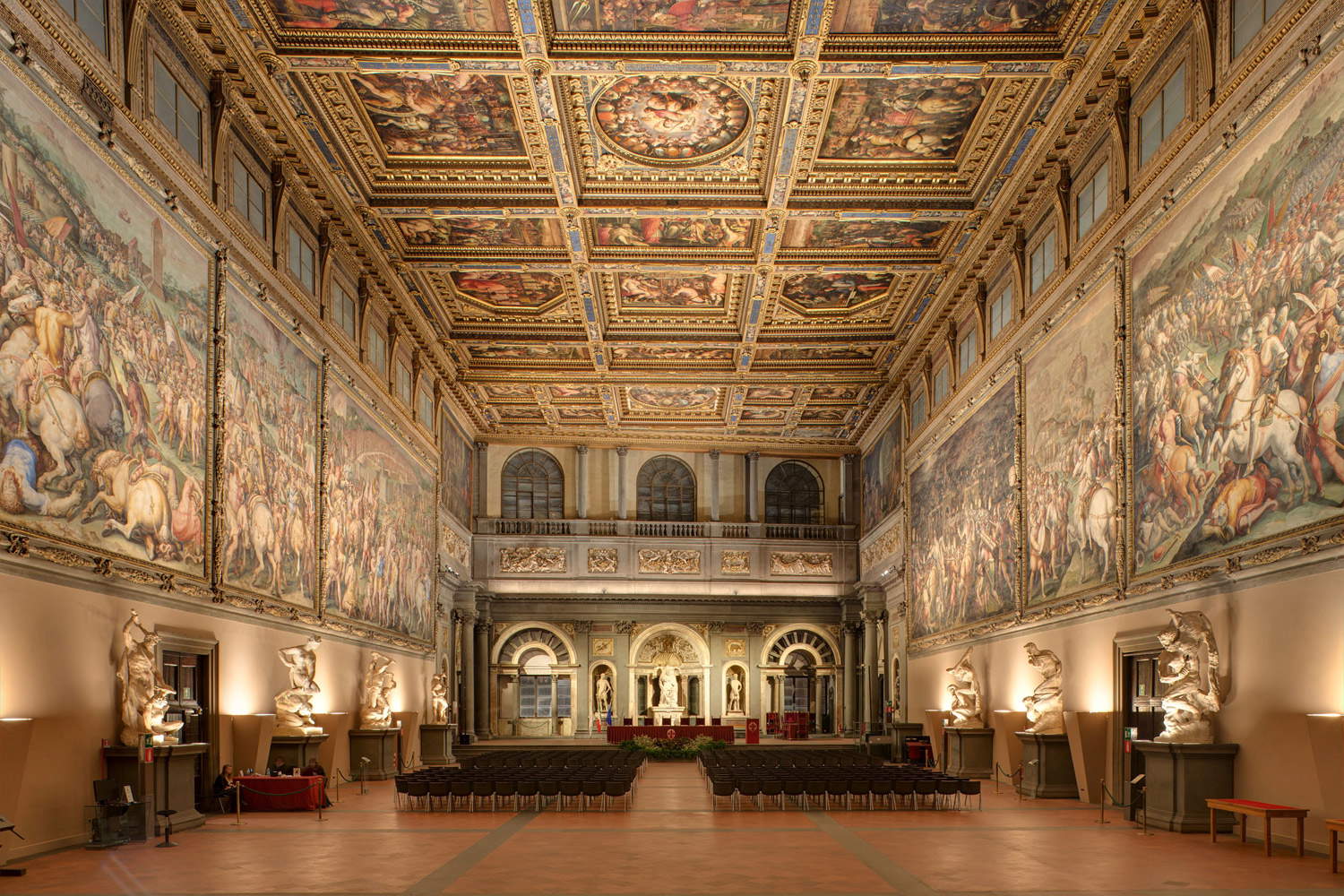 |
| The Salone dei Cinquecento in the Palazzo Vecchio in Florence. Ph. Credit Targetti Sankey |
The moment on which Leonardo da Vinci’s attention was focused is that of the fight for the standard, described in detail by the sources: “Il Capitano nostro,” wrote Neri di Gino Capponi in his Commentari referring to Pietro Giampaolo Orsini, “ran to the other side with about 400 horses, went to assault the inimical standard, and took it, and they were broken.” The day after the battle, the commissioners of Florence, Gino Capponi and Bernardo de’ Medici, wrote a dispatch stating that “the stendardi abiamo qui e per lo aportatore ve li manderemo senon che vorremo si perdessero.” And then again, the struggle is also well described by the notary Giusto di Anghiari in his Diario: “It was grandissima vittoria, e tolsaro loro gli stendardi. Fecisene gran festa e meritamente perché era la salute di Toscana. Niccolò Piccino escaped with about 1,500 horses in lo Borgo and the same night fled and passed the Alps to his great harm and shame.” Leonardo chose to depict the fierce battle between the leaders of the mounted armies in order to gain possession of the banner of the Milanese army.There are no known Leonardo originals, but only copies or derivations, the most famous of which is surely the Tavola Doria, recently attributed, though without unanimous consensus, to Francesco Morandini known as Po ppi (Poppi, 1544 - Florence, 1597), one of the major artists of the second half of the 16th century in Tuscany. Less well known, but no less important, are two drawings possibly taken from the original cartoon (which unfortunately is not known to us at the moment): one preserved in the collections of the Royal Netherlands in The Hague (perhaps the closest version to Leonardo’s original) and one kept in the Louvre, the work of an anonymous artist but retouched in the seventeenth century by Pieter Paul Rubens.
From these derivations we can get an idea of how Leonardo envisioned the scene: on the left, the condottiere Francesco Piccinino (Perugia, c. 1407 - Milan, 1449), son of Niccolò, who was to be depicted immediately at his side, both caught in expressions of brutality and violence, their mouths wide open in animalistic screams and their eyes caught in angry expressions. Flanking them are the patriarch of Aquileia, Ludovico Scarampo Mezzarota, and the nobleman from Abruzzo, Pietro Giampaolo Orsini, in quieter attitudes and wearing two helmets embodying symbolic values: Mezzarota, in particular, wears a helmet decorated with a dragon (which, according to art historian Frank Zöllner, a distinguished Leonardo scholar who has long dealt with the Battle of Anghiari, is a symbol of military valor and prudence), while Orsini wears a Corinthian helmet like the one worn by the goddess Athena. In contrast, Francesco Piccinino must have had armor decorated with goat horns, an allusion to the devil. In Niccolò Piccinino, on the other hand, people wanted to see a portrait of Mars, the god of war, but not to exalt him, but rather to highlight the negative traits that were associated with this deity in the Renaissance (a poem by the humanist Lorenzo Spirito Gualtieri, dated 1489, describes him thus: “Above a horse a strong knight / And all his arms were of fire / In his face full of a wrath and disdain / That made all that place tremble”): Mars, in his dimension as a vengeful, evil and treacherous god, in the mentality of the time lent himself well to being the deity with whom those captains of fortune were associated who were equally violent and willing to change their tunic with extreme ease. The fierce scene was to be closed at the bottom by two soldiers fighting with their bare hands, examples of the rough soldiery that in the Renaissance joined the ranks of the captains of fortune often poorly armed, or unarmed, and motivated almost exclusively by the possibility of enacting plunder and violence along the marches.
A not insignificant role was reserved for the horses, characterized (we see this from the derivations) by terrified expressions: Leonardo, as an animal activist, probably wanted to express his documented dissent against the war precisely through the figures of the two animals (“Leonardo,” wrote Louis Godart, “has admirably rendered the state of mind of the animals engaged in the struggle. The eyes of the two horses forced by their riders to clash and annihilate each other look fearfully at the two men tearing each other apart between their legs. I have the impression that the master wanted to express all the aversion of these animals to the clash into which the anger and madness of men have dragged them.”) Indeed, the work was not to be without political and allegorical implications. In the first case, the Battle of Anghiari was supposed to be a celebration of Florence’s strength and virtue, able to subdue a bestial enemy uninterested in glory (Leonardo had in fact intended to depict Francesco Piccinino in the act of fleeing: the young Umbrian was an unskilled captain of fortune, also known to have been defeated dishonorably by the Venetians at Mezzano in 1446), and prone to violence. He would also have been noted for the opposition between the reason embodied by the goddess Athena of Orsini’s helmet, and the wickedness of Mars who would find his personification in Niccolò Piccinino. “The Florentines,” Godart wrote, taking up Zöllner’s thesis on the work’s political message, “identified with the victorious Athena through prudent conduct of war. This additional element tends to reinforce the antithesis between two of the knights [...]. While Francesco Piccinino has a helmet decorated with goat horns that emphasize the bestial and diabolical character of the character, Pietro Giampaolo Orsini wears a helmet whose visor recalls the goddess of intelligence.” After all, Godart wrote again, Leonardo "knew he had to create a work with a strong political impact. It was to show through the depiction of the Battle of Anghiari the triumph of a thoughtful Florence, strong in its rights and institutions, over an army of brutal and ruthless mercenaries."
Finally, it is worth noting how Leonardo also wanted to cloak the work in his own personal idea, his rejection and hatred of war, which he called a “most bestial madness” in his Treatise on Painting. And the Battle of Anghiari therefore becomes, Godart writes, “an implacable denunciation of war.” Thus, moreover, the artist wrote in the Corpus of Anatomical Studies: “think it a most nefarious thing to tower life allomo [...], and not to want your wrath or malignity to destroy so much life, that truly he who esteems it deserves it.” War, according to Leonardo, became a necessary evil only if it was necessary to win freedom: “to maintain the principal gift of nature, that is, liberty, I find ways to offend and defend in stando siege by li ambitious tyrants,” he wrote in a note we find in the Ashburnham manuscript.
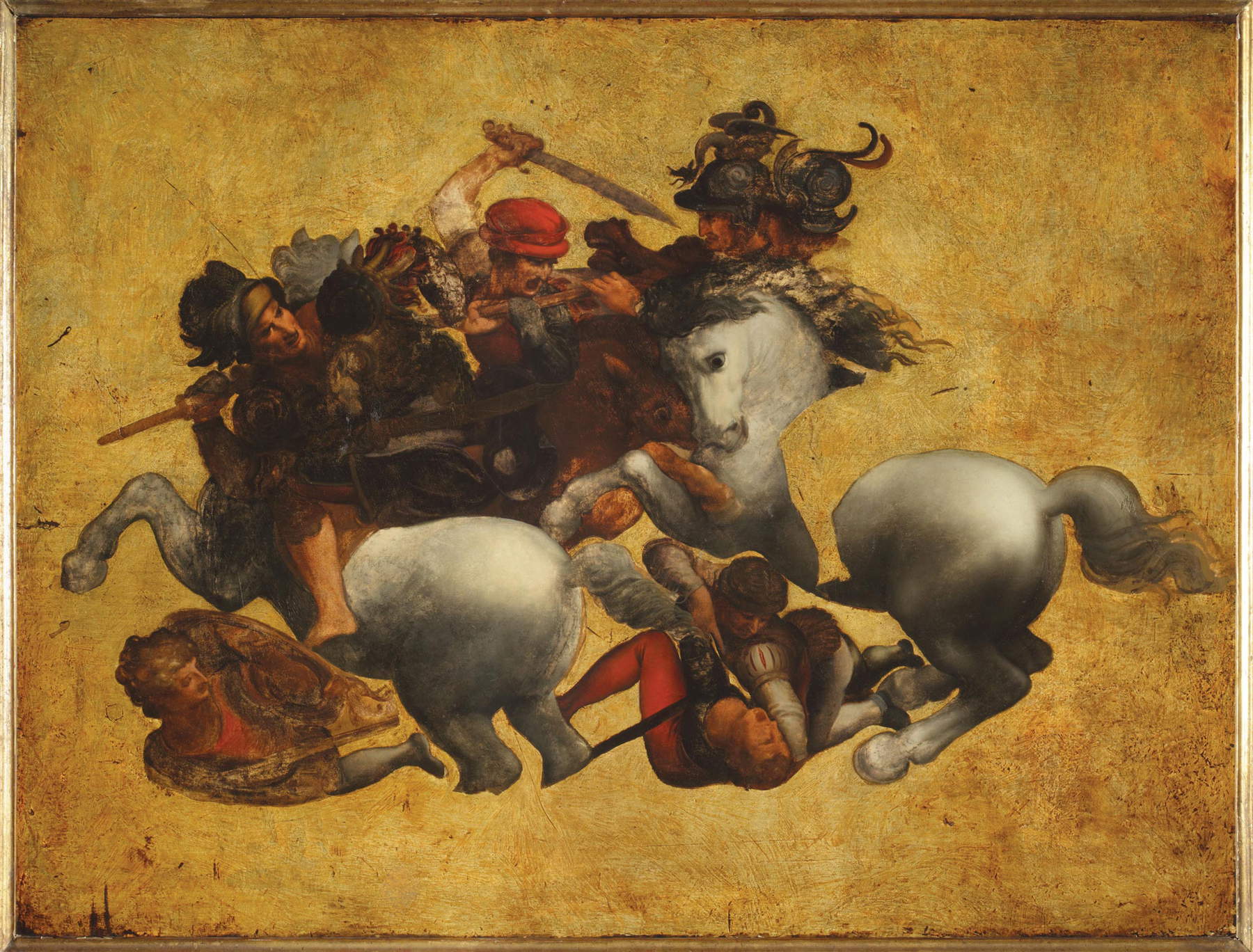 |
| Francesco Morandini known as Poppi (?), Tavola Doria (1563?; oil on panel, 86 x 115 cm; Florence, Uffizi Galleries) |
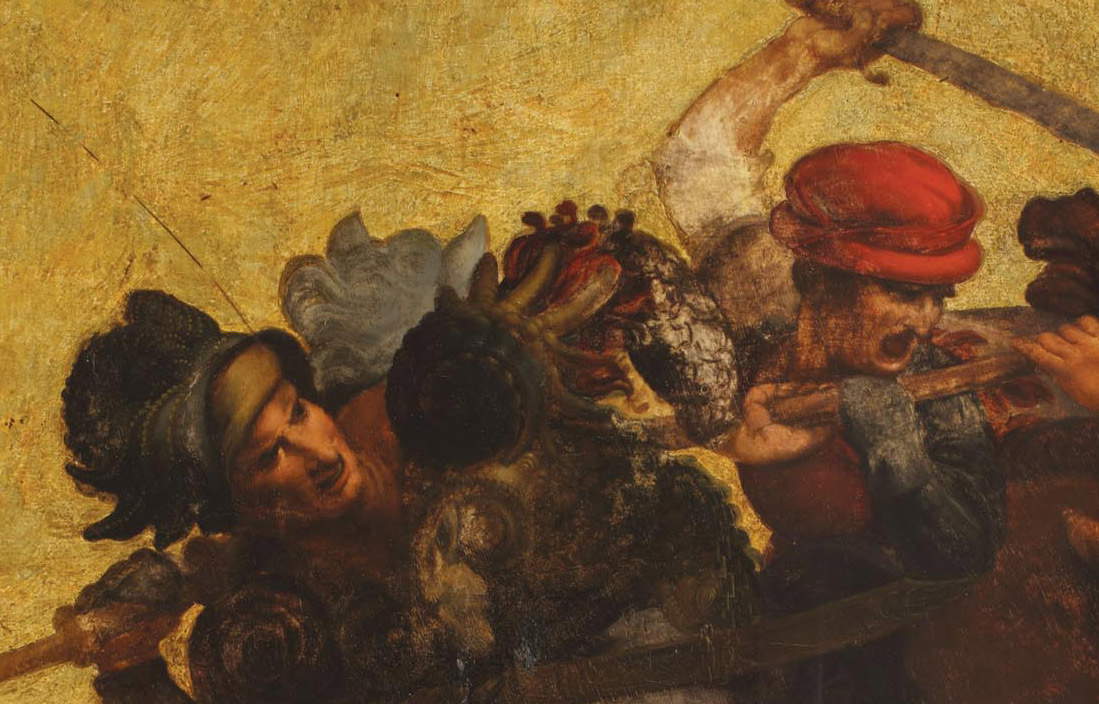 |
| Details of the Tavola Doria: Francesco Piccinino and Niccolò Piccinino |
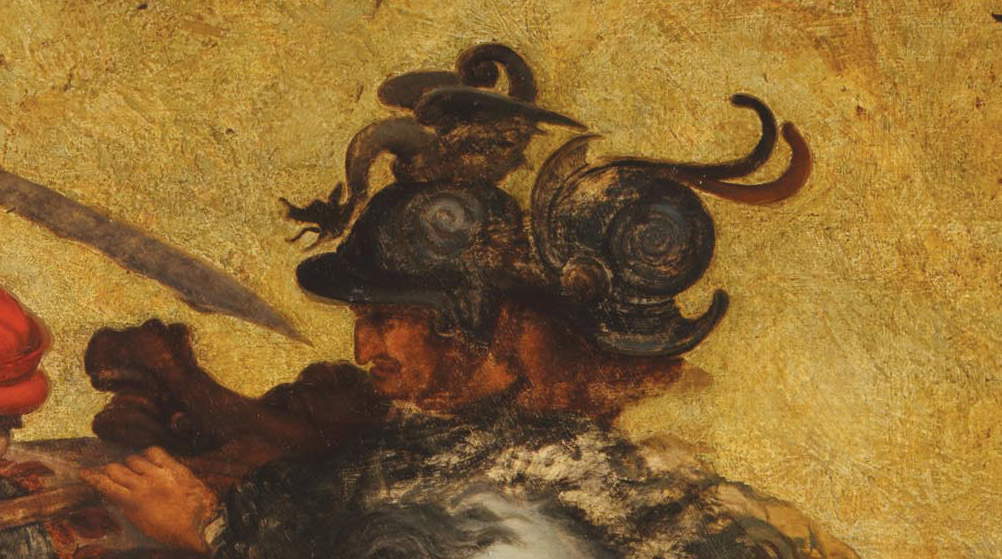 |
| Details of the Doria Table: Ludovico Scarampo Mezzarota and Pietro Giampaolo Orsini |
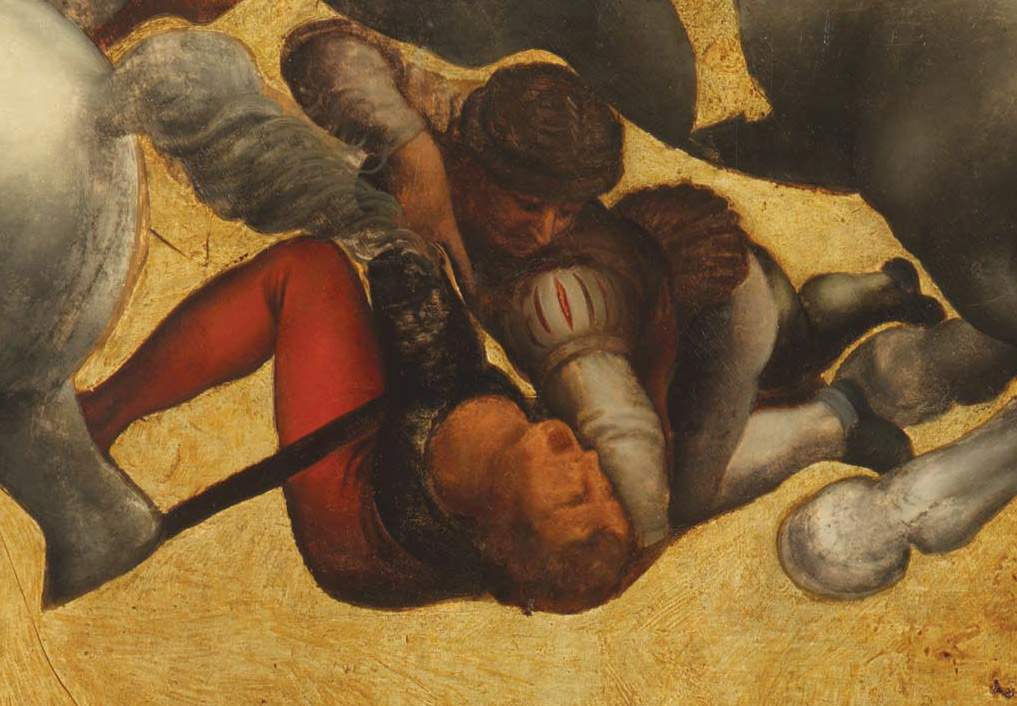 |
| Details of the Doria Table: the soldiers fighting on the ground |
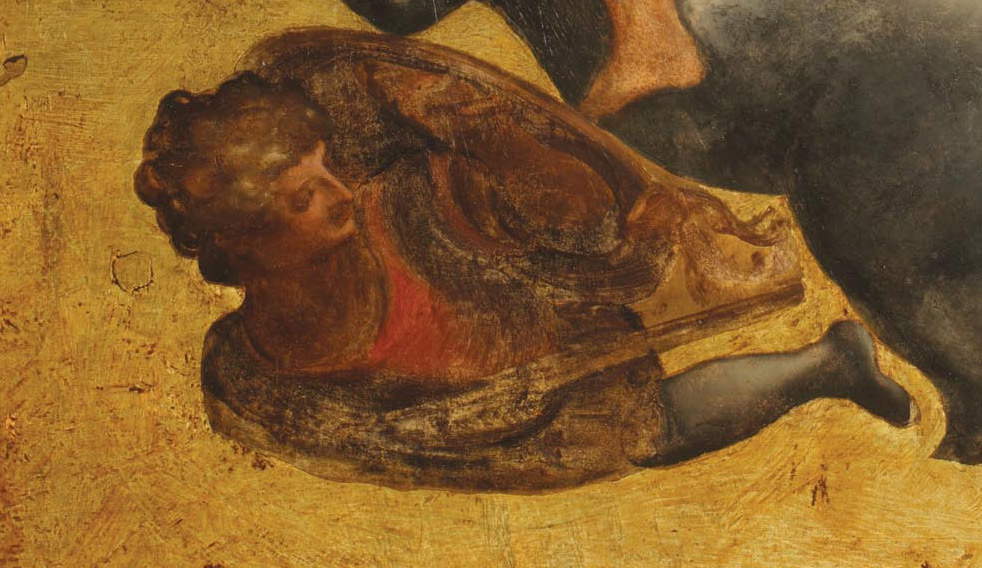 |
| Details of the Doria Table: the soldier with the shield |
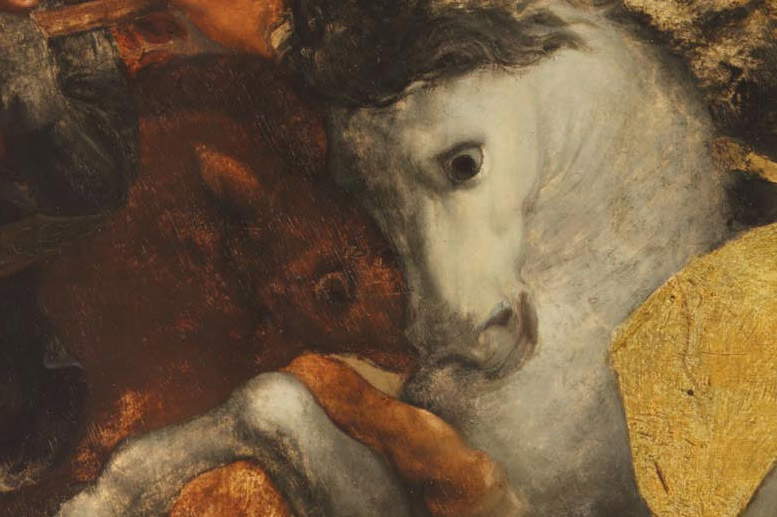 |
| Details of the Doria Table: the looks of the horses |
 |
| Anonymous artist, Copy of the Battle of Anghiari by Leonardo da Vinci (16th century; chalk, pencil and pen on paper, 435 x 565 mm; The Hague, Collections of the Royalty of the Netherlands) |
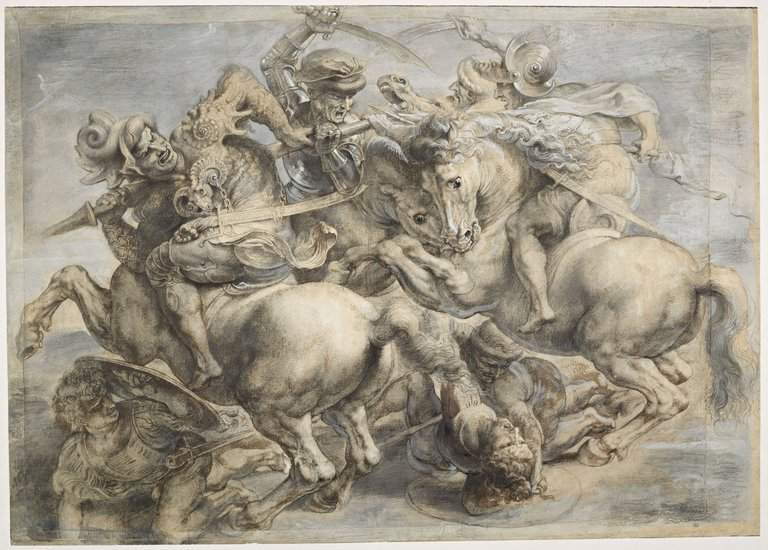 |
| Anonymous 16th-century and Pieter Paul Rubens, Copy of the Battle of Anghiari by Leonardo da Vinci (16th century with later retouches by Rubens; black pencil, pen and brown and gray ink, gray pencil and white and blue-gray pigments on paper, originally 428 x 577 mm later enlarged to 453 x 636 mm; Paris, Louvre, Département des arts graphiques) |
“Addi 6 di giugno 1505 in venerdi al tocho delle 13 ore cominciai a colorire in palazo nel qual punto del posare il pennelo si guastò il tempo e sonò a banco richiedendo li omini a ragone. The cardboard was torn the water was poured and rupesi the jar of water that was carried and immediately the weather failed and it rained insino a sera acqua grandissima and stette il tempo come notte”. This is the description of the beginning of the work, in a note written by Leonardo: the undertaking did not really begin under the best auspices, and in fact the Battle of Anghiari, as mentioned above, was never realized. It has long been believed that Leonardo wanted to experiment with theencaustic technique for his mural, to be used instead of the traditional fresco. The technique involved painting the work on dry plaster, and then drying it by heat given off by wood-fired cauldrons. This is the account provided by theAnonimo Magliabechiano on the unsuccessful outcome of Leonardo’s experiment: “lower down the fire added and dried [the painting, ed.], but up there on high, because of the great distance, heat was not added and the matter dripped.” Thus, on the other hand, Giorgio Vasari in his Lives: “And imagining himself wanting to paint in oil on the wall, he made a composition of such a thick mixture, for the gluing of the wall, that while continuing to paint in said room, it began to drip, so that in a short time he abandoned that.” Based on these narratives, it was thought that the heat of the pots had not been high enough to dry the upper portion of the painting, with the result that the higher portion would have leaked, ruining the entire work. Actually, according to a recent hypothesis by art historian Roberto Bellucci, things would have turned out differently: encaustic painting in fact involved the use of waxes (not oil), which would have melted anyway if exposed to a direct heat source. The heat, in fact, was, if anything, used to heat the support in order to make the colors dissolved in wax adhere better, according to the description of the technique given by Pliny the Elder (it was in fact already employed in ancient Rome). Had Leonardo chosen to work with encaustic, if anything the problems would have occurred at the top. According to Bellucci, it is therefore much more likely that the colors chosen by Leonardo were incompatible with the support: we can also corroborate this hypothesis according to an observation by the humanist Paolo Giovio (Como, 1483 - Florence, 1552), who wrote in his biography of Leonardo da Vinci compiled between 1523 and 1527, that in the Council Chamber of the Florentine Signoria there remains a battle and victory over the Milanese, magnificent but haplessly unfinished because of a defect in the plaster that rejected with singular obstinacy the loose colors in walnut oil. New studies conducted in 2020 by ateam led by Cecilia Frosinini, an expert on Leonardo da Vinci and director of the Restoration of Wall Paintings department at the Opificio delle Pietre Dure, finally concluded that the artist never painted anything in the Salone dei Cinquecento: he simply had problems preparing the support, and abandoned his idea.
What, then, remains of his hand? Only a few studies: there are some with the position of the horsemen and the composition of the melee, preserved at the Gallerie dell’Accademia in Venice, and then we have a drawing with some horsemen with banners at the Royal Library in Windsor, a sheet with studies for the two horsemen on the right kept in the Uffizi, and finally two sheets at the Museum of Fine Arts in Budapest, namely a study of a horseman’s head, and the most famous autograph study for the Battle of Anghiari, the one for the head of Niccolò Piccinino. There are no studies left, unfortunately, of the final composition: the drawing that comes closest is that on folio 215 in the Gallerie dell’Accademia in Venice, an exceptional demonstration, Annalisa Perissa Torrini has written, “of Leonardo’s incredible graphic ability in being able to concentrate the swirling melee of the battle, knowing how to render it with a few concise strokes, as in a miniature, but to sure realistic effect.” Here, in the upper half of the sheet, we find a melee between mounted combatants which, Perissa Torrini writes again, “is drawn with extremely rapid mark, which translates the immediacy of the idea with great confidence, knowing how to achieve the effect of the two tangled and opposing masses of combatants in whirling and chaotic movement by means of a strong chiaroscuro contrast. In the figures of pawns, on the contrary, the sign is deliberately broken, without shading, with the main intention of studying the various movements of the foot soldiers, bent in lunge, taken sideways, with bold twists of the busts and concentrated in the effort to strike the opponent with the greatest possible force.” These are reflections of what Leonardo da Vinci wrote in the Treatise on Painting: “The more the combatants are infra the turbulence, the less they will be seen and the less difference will be from their lumens to their shadows.” In the lower part of the sheet, however, another scrum is depicted, but more numerous: it is the most crowded of those known.
Equally important is the study for the head of Niccolò Piccinino, representing, almost certainly, the image of what the Umbrian condottiere must have looked like in the completed painting, as well as the other Budapest drawing, probably the almost definitive study of the head of Pietro Giampaolo Orsini. According to scholar Carmen Bambach, for the latter drawing Leonardo “first traced the outlines of the head, roughly, then shaped the shadows with parallel strokes, with his characteristic way of drawing from the bottom right-hand corner to the top left-hand corner. Then he rubbed the strokes to get an effect of continuity, and to reinforce the outlines he chalked quite hard with chalk on the paper.” These are sheets of the highest quality, where we see the heads of two of the protagonists at their most elaborate, and about which there is no serious doubt as to Leonardo’s autography. They are, however, all we have left of the Battle of Anghiari among what Leonardo made by his own hand: everything else is known from copies.
 |
| Leonardo da Vinci, Melee between horsemen, a bridge and isolated figures, study for the Battle of Anghiari (c. 1503; pen and brown ink on light walnut paper, 160 x 152 mm; Venice, Gallerie dell’Accademia, Gabinetto dei Disegni e delle Stampe) |
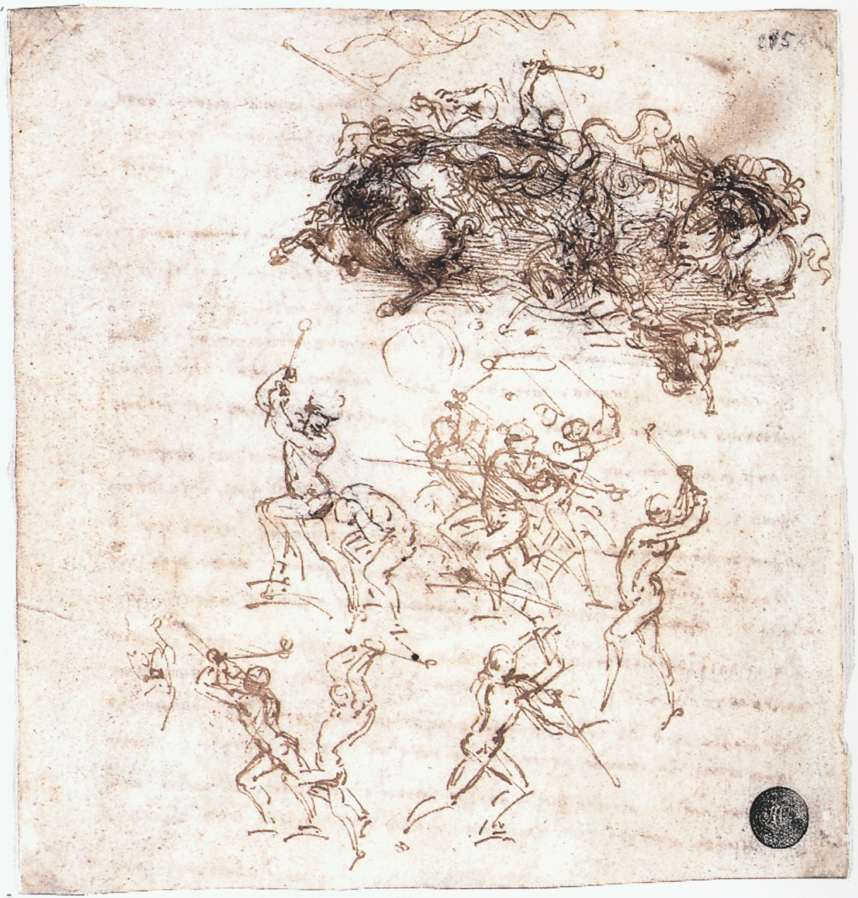 |
| Leonardo da Vinci, Cavalieri in lotta, study for the Battaglia di Anghiari (c. 1503; pen and black ink on paper, 145 x 152 mm; Venice, Gallerie dell’Accademia, Gabinetto dei Disegni e delle Stampe) |
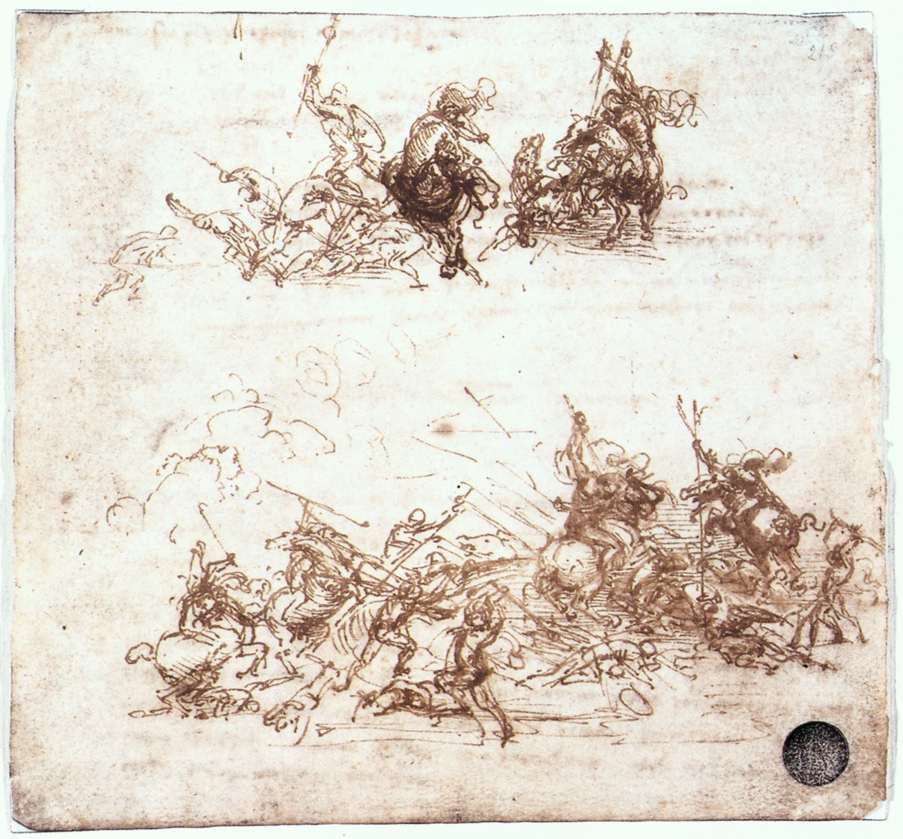 |
| Leonardo da Vinci, Mischiefs of Horsemen, study for the Battle of Anghiari (c. 1503; pen and black ink on paper, 145 x 152 mm; Venice, Gallerie dell’Accademia, Gabinetto dei Disegni e delle Stampe) |
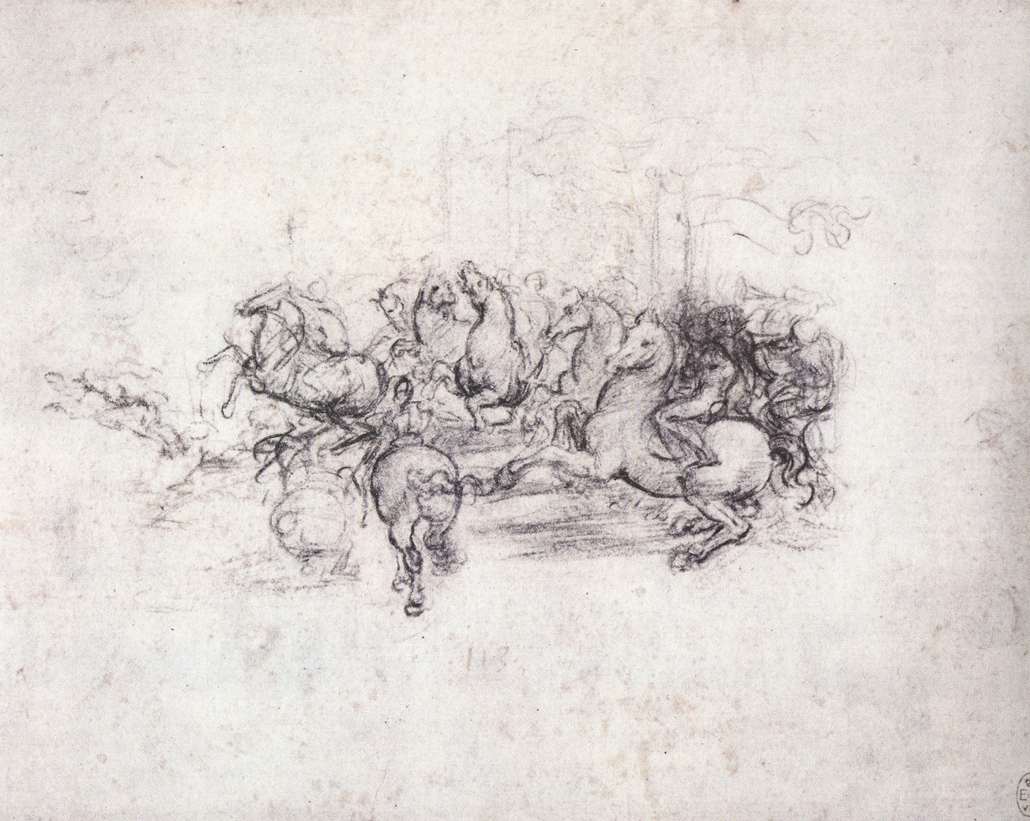 |
| Leonardo da Vinci, Knights with Banners, Study for the Battle of Anghiari (c. 1503; black chalk on light-colored paper, 160 x 197 mm; Windsor, Royal Library) |
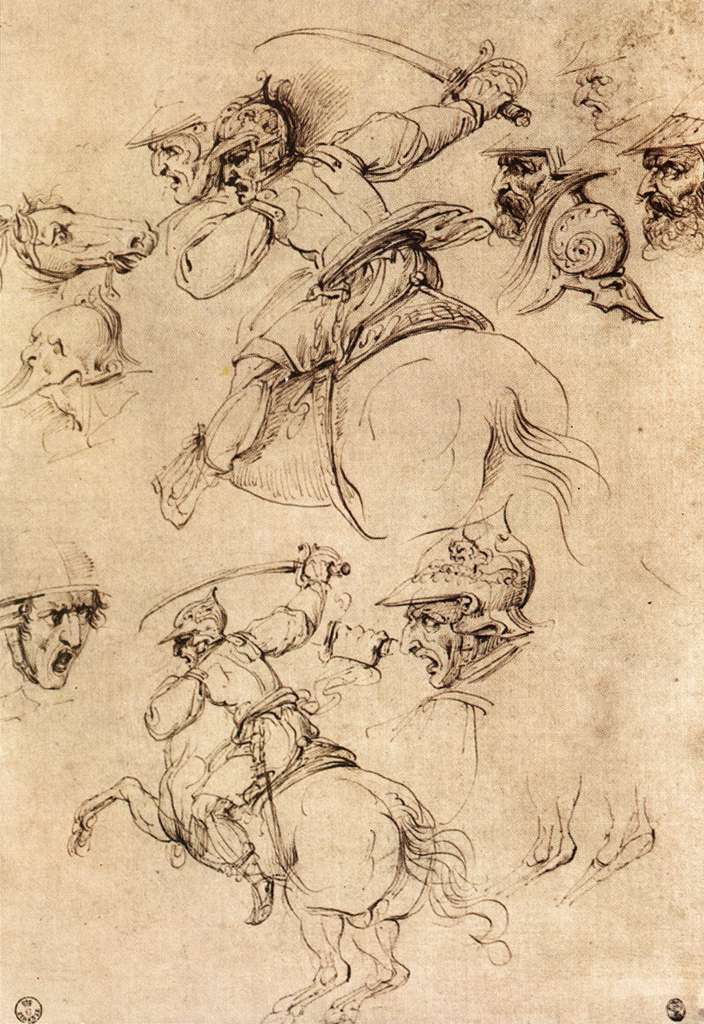 |
| Leonardo da Vinci, Studies for the Head of Niccolò Piccinino, study for the Battle of Anghiari (c. 1503; red and black chalk on pink paper, 191 x 188 mm; Budapest, Szépművészeti Múzeum) |
 |
| Leonardo da Vinci, Head of a Knight, Study for the Battle of Anghiari (c. 1503; red and black chalk on pink paper, 227 x 186 mm; Budapest, Szépművészeti Múzeum) |
 |
| Leonardo da Vinci, Studies for the Head of Niccolò Piccinino, study for the Battle of Anghiari (c. 1503; red and black chalk on pink paper, 191 x 188 mm; Budapest, Szépművészeti Múzeum) |
Prompted by the idea that Leonardo had tried to paint the Battle of Anghiari on a wall, many have wondered what happened to any remnants of the mural: the last reports of supplies for the work date back to October 31, 1505, and by May 30, 1506, the artist had already left Florence to return to Milan. Leonardo would only return to Florence between 1507 and 1508, but without completing the work. In 1510, the chronicler Francesco Albertini, in describing the “Sala Grande Nuova del Consiglio Maggiore,” stated that there was “a panel by Fra Filippo, li cavalli di Leonardo Vinci et li disegni di Michelangelo” (although it is not certain that “li cavalli” were those painted on the wall: in fact, it could be the panel with the finished composition that Leonardo prepared before his undertaking in the Sala del Papa in Santa Maria Novella). But there is a document dated February 23, 1513, attesting to a payment to a carpenter, Francesco di Cappello, to “arm the fighure painted in the Sala grande della guardia, by the hand of Lionardo da Vinci.” And then, in the 1920s Giovio reported, in the above passage, that in the Sala del Connsiglio was the “battle and victory over the Milanese, magnificent but unfortunate unfinished.” However, it is likely that all these texts refer to the cartoon or panel executed in the Pope’s Hall, and not to any fragment, so much so that, moreover, Vasari in his Lives makes no reference to any remains of the work.
As is well known, on the wall that would have housed the Battle of Anghiari, Giorgio Vasari executed the magnificent frescoes, painted between 1562 and 1565, which can still be admired today in the Salone dei Cinquecento, and which also depict scenes of battles won by the Florentines. And if Vasari, in his Lives (the second edition, the Giuntina, is from 1568), does not mention any Leonardo fragments, it is highly probable that already when he had to work on the work nothing was preserved of what the Vincian had attempted in the hall. Yet despite the fact that there was no evidence that anything of Leonardo’s had survived in the Salone dei Cinquecento, a campaign of investigation, led by engineer Maurizio Seracini, founder of the Center of Interdisciplinary Science for Art, Architecture and Archaeology at the University of San Diego in California, was initiated in 2007 with the goal of unearthing the Battle of Anghiari. According to Seracini, Vasari would act to preserve Leonardo’s painting behind his fresco, the one depicting the Battle of Scannagallo. The campaign first began with non-invasive studies, after which, in 2011, it moved to the operational phase: in August of that year, scaffolding was installed to allow Seracini’s team to probe the wall through radars that were supposed to detect the cavity that, according to Seracini, hid Leonardo’s painting (in October, Vasari’s fresco was actually pierced, with a huge backlash of controversy and unanimous opposition from the scientific community). The engineer based his idea on the presence of this cavity behind the fresco, and on the presence of some banners with the inscription “Cerca trova,” misinterpreted as an invitation by Vasari to look for Leonardo’s work, but actually (and much more simply) a reference to an episode in Florentine history related to the battle depicted, as was also explained extensively on these pages by Federico Giannini at the time of the events. Seracini took some color samples, extracted by piercing Vasari’s work, and was convinced that he had found “Leonardo’s” pigments (in fact, at the time all artists used the same colors: there were no artists who used pigments exclusively). The Opificio delle Pietre Dure asked to study the extracted fragments, but never received them: it was later discovered that they were not pictorial materials, but common elements in masonry of the time. In any case, in 2012 the research ended, and no one ever thought of pulling Leonardo’s work from the wall of the Salone dei Cinquecento again.
So what happened to the work? The word “end” on the matter came in October 2020. “There is no Battle of Anghiari under Vasari’s painting in the Salone dei Cinquecento in Palazzo Vecchio”: this was the declaration of Cecilia Frosinini, following a conference whose results were published in the book La Sala Grande di Palazzo Vecchio e la Battaglia di Anghiari di Leonardo da Vinci. From Architectural Configuration to Decorative Arrangement, from 2019 but presented the following year. The new studies, as mentioned above, came to the conclusion that Leonardo never painted the battle on the wall of the hall, despite the fact that the cartoons are proven and documented to exist. Unfortunately, the preparation of the wall did not go smoothly, the Battle of Anghiari was never painted, and for years an attempt was made to get a nonexistent work out of the Salone dei Cinquecento.
Warning: the translation into English of the original Italian article was created using automatic tools. We undertake to review all articles, but we do not guarantee the total absence of inaccuracies in the translation due to the program. You can find the original by clicking on the ITA button. If you find any mistake,please contact us.